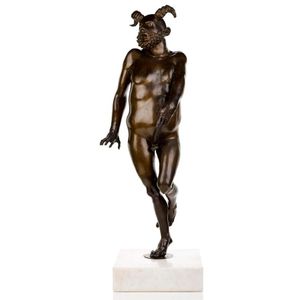French Bronze Gas Light with Female Form Cornucopia Fitting
Large French patina bronze female form gas light, ex Paris Hotel, depicting a semi-nude, half-length young female holding aloft a cornucopia gas light fitting, all standing on a tapering C scroll square form support on four scroll feet, 221 cm high
You must be a subscriber, and be logged in to view price and dealer details.
Subscribe Now to view actual auction price for this item
When you subscribe, you have the option of setting the currency in which to display prices to $Au, $US, $NZ or Stg.
This item has been sold, and the description, image and price are for reference purposes only.
- Patination / Patina - In broad terms, patination refers to the exterior surface appearance of the timber, the effect of fading caused by exposure to sunlight and air over the course of a century or more, changing the piece to a soft, mellow colour.
As patina is very difficult to replicate, it is one of the most important guides to determining the age of furniture.
Patina is also the term applied to the bloom or film found on old bronzes due to oxidisation. - Cornucopia - The cornucopia, literally the horn of plenty, is a symbol of abundance and wealth. It is traditionally is represented by a curved goat horn overflowing with grain and fruit.
Modern cornucopias are often depicted as horn-shaped baskets filled with food, and this symbol is often associated with the harvest. This decorative device has a long and ancient history, with roots in Greek mythology.
In one version, when Zeus was playing with the goat Amalthea he accidentally broke off one of her horns. To atone for this, Zeus promised Amalthea that the horn would always be full of whatever fruits she desired. This became the cornucopia of the Roman goddess Copia, the personification of plenty. Other goddesses, including Fortuna and Pax, also held the cornucopia.
In furniture and decorative arts, cornucopia as a decorative element have been popular since the 16th century and can be found on items as diverse as light fittings and candelabra to clocks, sculpture and statuary and furniture.
In ceramics, cornucopia shaped vases were popular in the 19th century, in singles and pairs. - Bronze - An alloy of copper and tin, traditionally in the proportions of about 9 parts of copper to 1 part of tin.
The discovery of bronze in Western Asia in the 4th century enabled people to create metal objects which were superior to those previoulsy possible because of its strength and hardness, and it has been used throughout the world for weapons, coins, tools, statuary and other decorative items.
It is very fluid in a molten state, and its hardness, strength when set, and non-corrosive properties makes it most suitable for casting sculpture.
This item has been included into following indexes:
Visually similar items

Large bronze figure group (2 Adults & 2 children) signed Clodion, 64 cm high
Sold by
in
for
You can display prices in $Au, $US, $NZ or Stg.

Brian Engris (b.1943), satyr, bronze cast figure, from the 'Dancing Gods' series, height 85 cm, width 26.5 cm, depth 26.5 cm
Sold by
in
for
You can display prices in $Au, $US, $NZ or Stg.

Large bronzed terracotta figure of a child, 104 cm high, on wooden stand. Repairs
Sold by
in
for
You can display prices in $Au, $US, $NZ or Stg.

Cast iron figure of Wellington
Sold by
in
for
You can display prices in $Au, $US, $NZ or Stg.
